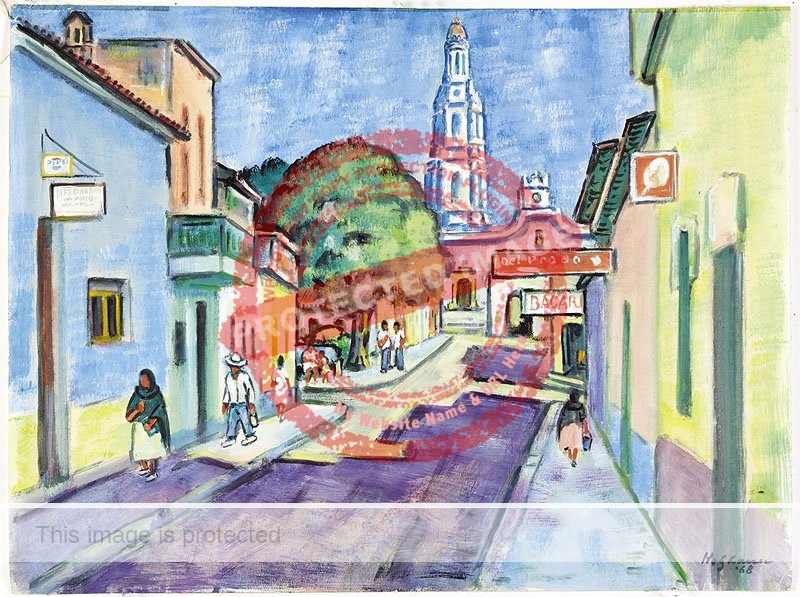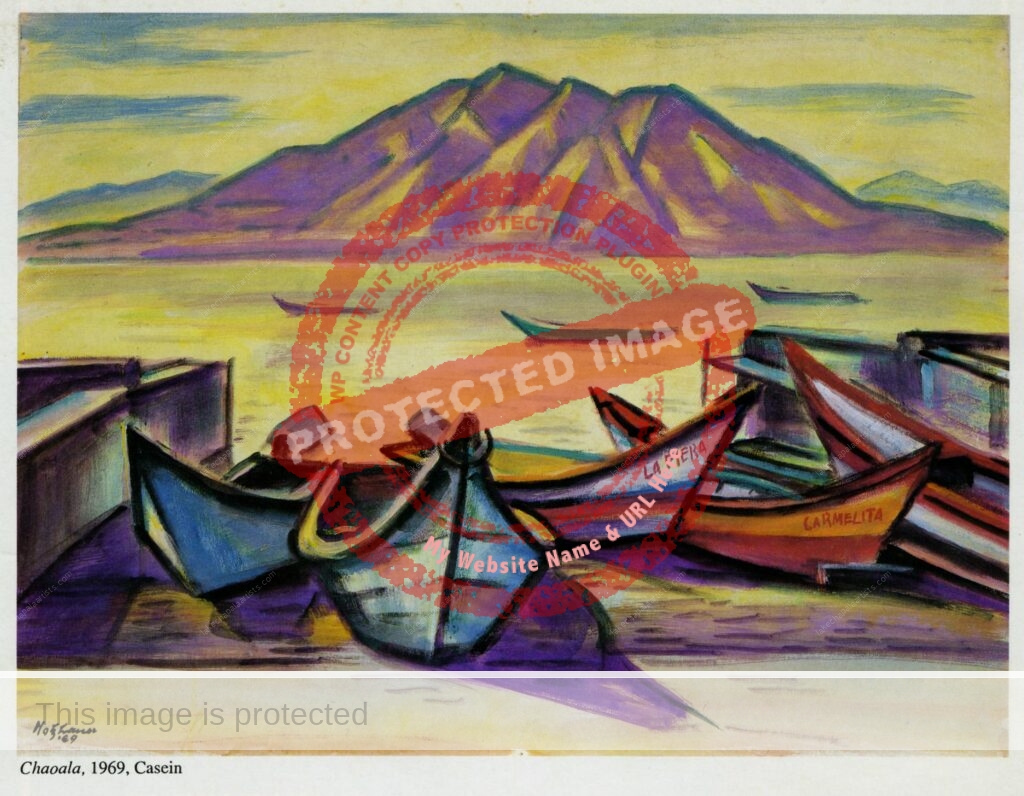Emil Eugen Holzhauer (1887-1986) was a renowned German-American painter and teacher of art who died a few days shy of his 100th birthday. His primary mediums were watercolor, oil, and casein (a fast-drying, water-soluble medium derived from a milk protein).
The details of his visits to Lake Chapala are scanty. His painting “Ajijic, Mexico” (dated 1968) came up for auction in 2013, while his casein painting “Lake Chapala, Mexico” (dated 1969) was featured on the back cover of “Museum and Arts” (Houston’s Art Journal) in October 1993.

Emil Holzhauer: Ajijic, Mexico (1968).
Holzhauer had received two Carnegie grants in the late 1940s to study in Mexico, and had visited and traveled in the country on several occasions prior to the completion of these Lake Chapala paintings. He is also known to have painted scenes in Mitla (Oaxaca), Taxco (Guerrero) and Manzanillo (Colima).
Holzhauer was born on 21 January 1887 in Schwabisch-Gmund, Germany. While serving an apprenticeship in a silver and metalwork factory, he studied art at the Staatliche Werkkunst Schule.
He moved to New York City in 1906, where he took a series of factory jobs, to support himself and save money for art classes. He enrolled in night classes at the New York School of Art in 1909 where he studied for three years under the charismatic Social Realist painter Robert Henri, who became a close friend.
In 1913 Holzhauer attended the famed Armory Show which brought avant-garde artists such as Matisse and Cezanne to the attention of the American public. Both Holzhauer and Emil Armin (another painter of European origin who would later paint Lake Chapala) were inspired by the sharp contrast between these works and their own prior art training.
Holzhauer held his first solo exhibition in New York City in 1915, and thereafter exhibited regularly in the city, in both one-man and more than 70 group exhibitions. Many of Holzhauer’s best-known works depict working-class homes and neighborhoods. The lanes and buildings may look dilapidated but his watercolors reveal an intrinsic beauty.
Despite having no formal college credentials, Holzhauer became a distinguished teacher of art. His art teaching career began at a summer camp in upstate New York (1932) and then included positions at Bennett Junior College, Millbrook, New York (1938-1942), Asheville School for Boys, Chicago Art Institute, and as professor of art at Wesleyan College, Macon, Georgia (1942-1953).
After his retirement from Wesleyan College, Holzhauer and his wife moved to Niceville, Florida. He was a guest instructor at the Norton Art Gallery in West Palm Beach and continued to travel, paint and exhibit until his eyesight began to fail in the early 1970s.
In his artistic career, Holzhauer collected many awards, including prizes in Germany for jewelry and silverware, as well as the Logan Medal and Purchase Prize (for Patricia) at the 1930 International Watercolor Exhibition in Chicago. His painting, Village Street, January, was exhibited at the 1939 New York World’s Fair, and was subsequently included in a National Art Society publication of the exhibition’s sixteen “most representative” pictures.
His one-man shows include:
- New York: Hanfstaengel Gallery (1915)
- Rochester, New York: Memorial Art Gallery (1929)
- New York: Morton Gallery (1931)
- Baltimore Museum of Art (1933)
- New York: Rockefeller Center (1934)
- St. Petersburg Art Club, Florida (1955)
Retrospectives include the Pensacola Museum of Art (1983); “Emil Holzhauer, American, 1887-1986: a retrospective” at the Guarisco Gallery in Washington D.C. (Ca 1990); and “Emil Holzhauer (1887-1986): Bygone Landscapes – Journey Through the Americas” at the Gerhard Wurzer Gallery, Houston, Texas, in 1993.

Emil Holzhauer. 1942. The owner of this painting, dated 1942, would love to learn more about it, if anyone has information to share.
His works are included in the collections of Museum fur Natur & Stadtkicultur, Schwabisch-Gmund, Germany; Whitney Museum of American Art, New York; Chicago Institute of Art; Denver Museum of Fine Art; Los Angeles Art Association; Rochester Memorial Art Gallery; Albany Institute of History and Art; Syracuse Museum of Fine Arts; Monhegan Island Museum, Monhegan Island, Maine; University of Georgia, Athens, Georgia; Museum of Arts and Science, Macon, Georgia; The High Museum, Atlanta; Pensacola Art Center, Florida; Municipal Art Gallery, Mobile; Panama City Art Association, Panama City, Florida. The largest collection of his works is at Okaloosa-Walton Junior College in Niceville, Florida.
The story of Holzhauer’s early struggles and eventual success as an artist is skillfully told by Audrey Edwards in her “creative non-fiction” book, Emil Holzhauer: Portrait of an Artist (Ceshore Publishing Company, 2001).
Sombrero Books welcomes comments, corrections or additional material related to any of the writers and artists featured in our series of mini-bios. Please email us or use the comments feature at the bottom of individual posts.
Tony Burton’s books include “Lake Chapala: A Postcard History” (2022), “Foreign Footprints in Ajijic” (2022), “If Walls Could Talk: Chapala’s historic buildings and their former occupants” (2020), (available in translation as “Si Las Paredes Hablaran”), “Mexican Kaleidoscope” (2016), and “Lake Chapala Through the Ages” (2008).

Thanks–I really enjoyed this and it was great to see the Mexico that existed 50 years back through these works.–bill
I purchased a painting 25 years ago, in Milton FL this is a1942 water color painting of trees the wood’s maybe,. original watercolor matting and frame painted by Holzhauer in 1942 trying to find out a little bit of information about the painting.
Gladys, Thanks for the comment and query. If you’d like to send me a photo of your painting (as an attachment to an email – I can add it to this post and see if it jogs anyone’s memory. Regards, TB.
Hi gladys master here checking in on the painting above to see if anyone knows of this painting
I’m still enjoying my painting, Artist Emil Holzhauer 1942 Lake Chapala, to think 83 years ago this man painted his way through America, I find it very interesting.
As well you should! I’m still hoping someone will shed some more light on Emil Holzhauer.